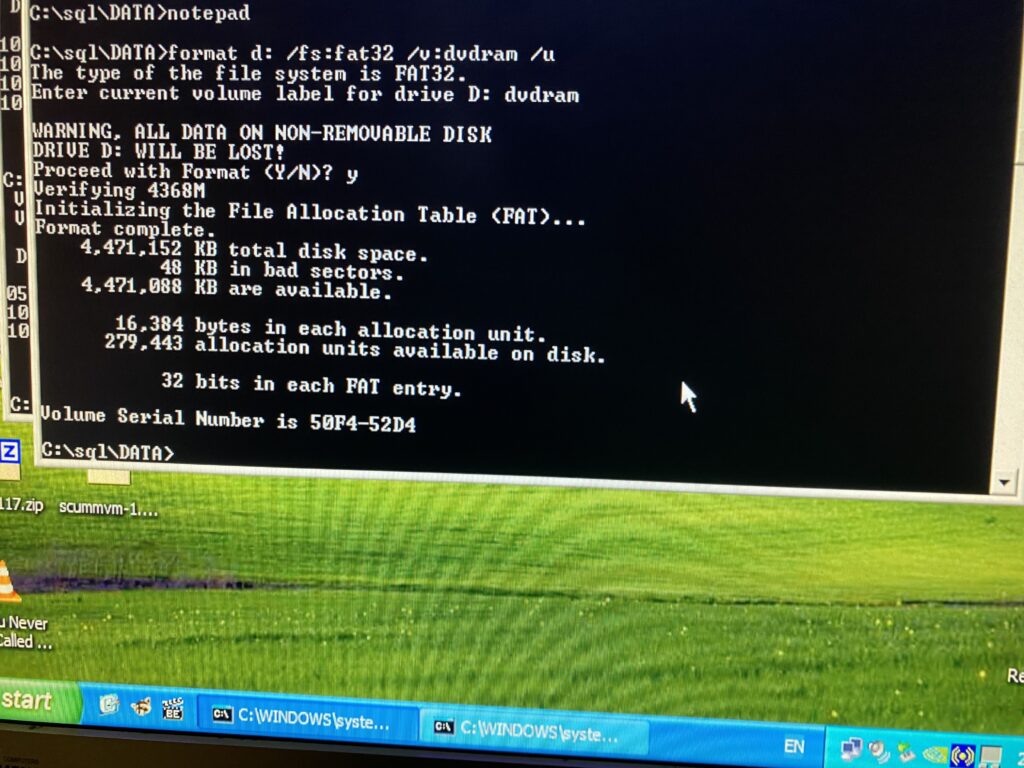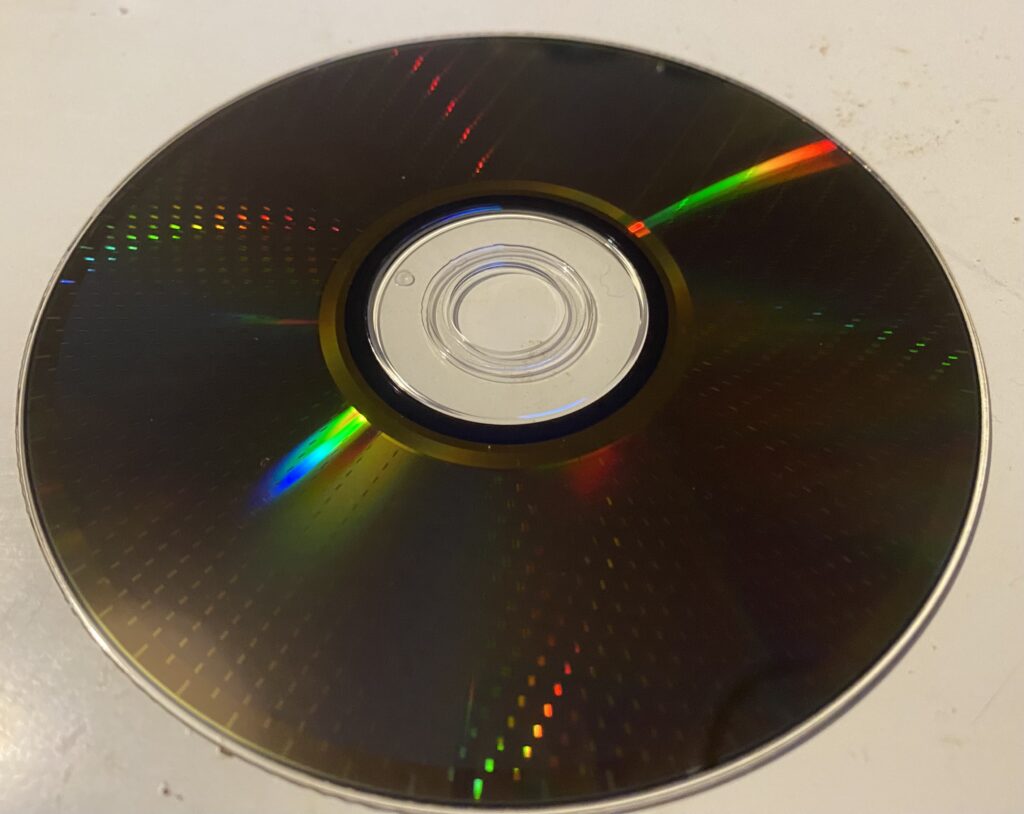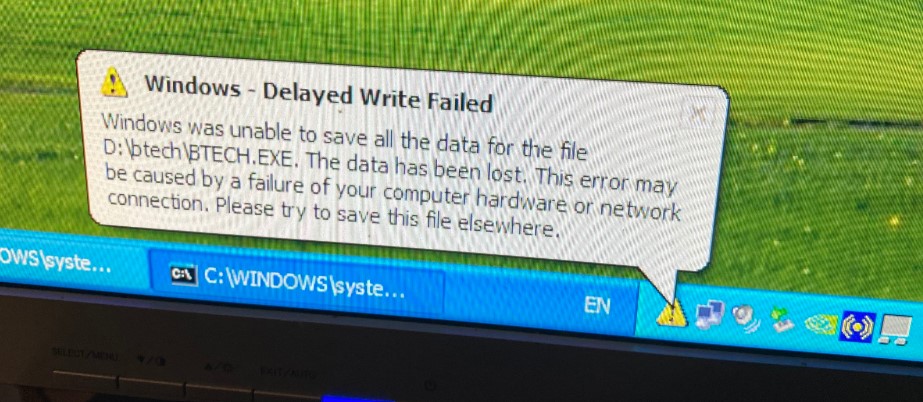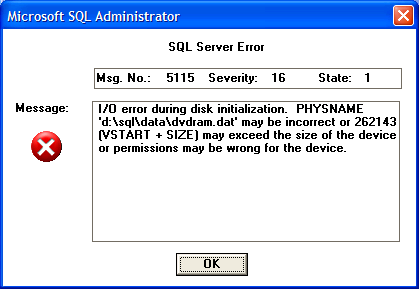I’m not sure why I never heard of this format back in the day when it was relevant. On the surface it sure sounds great, 4.7GB capacity, widespread vendor support, and there is no ‘sessions’ to close, or the entire disc needing to be erased to re-use the disc.
Enter DVD-RAM, it’s not a MO (magnetic optical drive), it works by cooking the disc to flip the bits. But still it’s a read/write optical disc, that uses lasers, what isn’t to love?
Well sadly the answer is pretty much eveything.
I think I found the format from the video “DVD-RAM: The Disc that Behaved like a Flash Drive” from Technology Connections.
Curiosity got the best of me, I paused the video, and bought 2 used discs for a whopping 3.99, and a 4.99 drive. Sure, it’s all cheap but how bad could it be? The discs were used in some DVD video production, and formatted UDF. I used XP to format them as FAT32. First thing is format from the CLI so you can clearly see what is going on.

I did this after the fact, and yeah bad sectors. This is the hint of why everything I tried on this blasted disc at best ‘kinda worked’ but for the most part didn’t. It’s not a little damaged, its totally worthless.
Battle Tech is so small it’ll fit with a copy of Windows/386 on a 1.44mb floppy disc, and yet the DVD-RAM struggled with this level of data.
I was going to do some kind of SQL bench thing of how terrible it was, but I couldn’t even create a database.
Everything I tried was non-stop failure.
I then tried the other disc for the hell of it.
Format complete.
4,471,152 KB total disk space.
4,471,136 KB are available.
16,384 bytes in each allocation unit.
279,446 allocation units available on disk.
32 bits in each FAT entry.
Volume Serial Number is 941A-7AA7And yeah, it worked. All my “simple” tests just worked, and they completed in a fraction of the time the other disc struggled and failed with. Using MS-DOS level file sized stuff it seemed to work great with, however remembering the optical drive they do love to spin up and down, and if the disc is spun down, reading files can take SECONDS… So that kind of sucked.
Formatting the disc takes 30-45 minutes. It is not fast by any stretch of the imagination. During the format you can hear the drive constantly spinning up and down. Clearly you can see why hard disks rock, as they can keep the media spinning at the same rate. I’m not sure if it’s seeking around a lot or what is going on. I have to wonder if it was possible for any drives to maintain a constant speed? Would it have mattered?
I’ve seen outrageous claims on how long the media should last, far too long for it to be viable. When I hear about all the early SEGA CD drives all dying, turns out those lasers don’t last for centuries, there is no way this media is going to be viable at all.
I have to wonder if there really is any validity to this medium. I mean I have 2 discs that were recorded on in 2008, and in 15 years I have a 50% failure rate. Not good.
It’d be really terrible to recommend this stuff for pretty much of anything. The spinup/spindown basically kill any hope of using it for random access.
It’s no surprise that the ever increasing capacity of flash drives, and the economies of scale driving prices of flash down killed any hope for optical media.
The real question is will any 8/16MB flash sticks work in 2024 and beyond?
It’s all so depressing. If you have anything even remotely important on any optical disks, get them over to NVME or hell anything else.




Honestly, this just sounds like a crappy burner being the issue. I’ve used DVD-RAM discs pretty extensively with no issues in the past, and the Redbox phone at my work place would back up to DVD RAM without issue. That system was in place for years.
The second disc sure did work better, but that spin time… Have you tried running programs off it that periodically access data? Write buffering seemed ok, but reading a small file every few minutes seemed to suck.
You do know that the usual NAND flash disks (nvme or sata or whatever) have data retention of only some months, right?
I’ve been using my Mac Pro very infrequently with gaps in months and it’s still there….
I still own an 8 MB Sony MSA-8A Memory Stick.
I just tried it and it is still working well.
What makes these old flash devices less useful are their capacities. Even back in 1999 when I received it when buying a Sony DSC-F505 camera it was barely usable. The photos the camera produced were on average 400-600 KB in size
so the flash drive would hold maximum 20 photos.
Then when upgrading to a Sony DSC-S75 in 2001 which produced photos sized around 1.2-1.5 MB it was
unusable.
I don’t think DVD-RAM was meant for running programs directly off of it. Also there may be some performance problems with FAT32 as updating the FAT requires seeking to the beginning of the disc. I think UDF design mitigates some of these problems, but XP is going to require aftermarket file system drivers to use it.
it certainly feels more geared to small on the fly updates, like transaction logs. It certainly is faster than opening/closing sessions.
I have to really wonder about the longevity of the media & lasers. The disc that does work has a marker date from 2005 so its approaching the end of 25 year expected life, which maybe is the other scary thing, 1998 doesn’t seem that long ago.
I’ve had excellent luck with DVD-RAM. It was great when usb sticks were still relatively small and expensive. DVD-RAM drives were slow, I remember getting about 4x speed with frequent seeking interrupting file transfers.
Unfortunately when buying used old drives and media, there is no way of knowing the amount of abuse inflicted on them.
Any filesystem other than UDF, was always considered a bad idea. Most filesystems intended for hard disk usage tended to overwrite the same sectors repeatedly.
If you still have the disks you ought to dig them up and see how many made it this far! It’s be interesting to have a wider sample!
I managed to dig out the only used DVD-RAM disc I had left, and plopped it into my BD-RE drive. It is a Maxell 3X speed disc.
It looks like I last written to it in 2007 and the disc was filled with drivers and software for my Socket 939 Athlon64 PC that ran Windows 98SE. Yes, I was still actively using Windows 98 in 2007…
So far the disc 100% still works, actually slower than I remember. I’m getting about 1MB/s read speeds.
Yeah they aren’t very fast at all! I have a feeling a lot of people remember them a lot better than they really were.
I’m sure if I’d known about them I would have used them as archival only it seems the time saved would be not having to do the session open/close dance.
But formatting does take forever. But we were used to insanely slow stuff back then.
Just like with floppies, this also depends on media quality.
Older expensive CD-R/RW formulations and discs tend to endure more than the last, cheap “5 cents” chinese discs and even many last manufactured (40x) discs. Old 4X discs still work fine in this year and read fine, as if them were pressed discs. But backups made on cheap discs don’t even read after only 2 years, throwing bunch of unrecoverable read errors.
Oh these were Panasonic discs. 3x speed so they are not all low quality.
From what I understand the DVD-RAM discs were pushed as being far superior to cheap CD-R media. But with a 50% failure rate I wouldn’t trust this format at all.
I need to check my 8 MiB CF card. I used to put a MirBSD ISO on it and boot that on Alix boards to test them.
pretty sure it’ll be fine but check. I bought a cisco 32mb card for my SinclairQL, and the IOS was on there just fine, but it was some random 12.0 for the 7200 I wasn’t interested in… But it was fine.